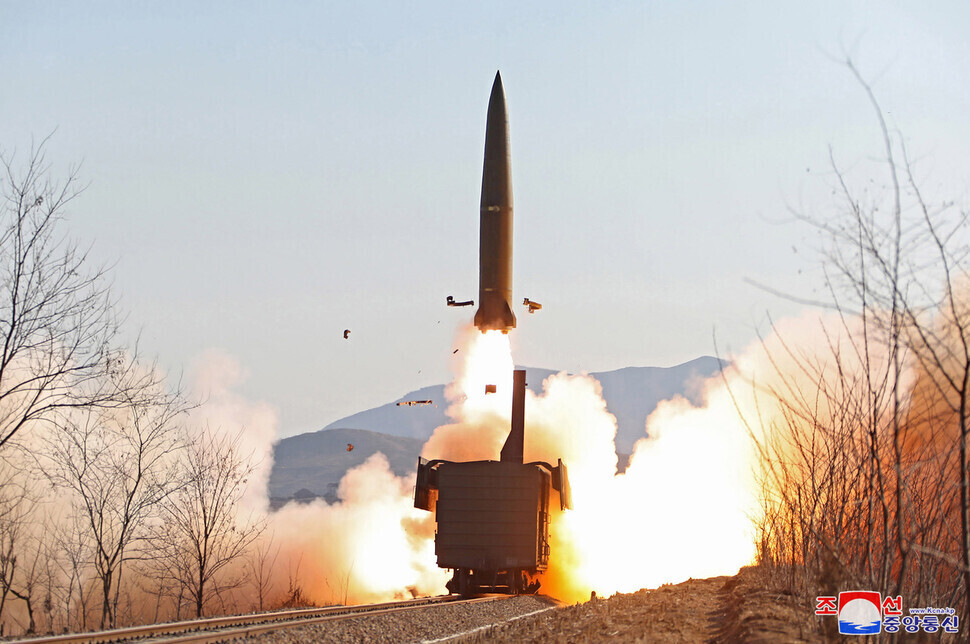hankyoreh
Links to other country sites 다른 나라 사이트 링크
Joint Chiefs: N. Korea fired 2 ballistic missiles from Pyongyang airport on Monday

South Korea’s Joint Chiefs of Staff announced Monday that North Korea had launched two projectiles presumed to be ballistic missiles one after another, with just four minutes between the two. This was the North’s fourth show of force this year, following previous missile launches on Jan. 5, 11 and 14.
The Joint Chiefs said that they had detected two launches of what they presumed to be short-range ballistic missiles from an airfield in the Sunan District of Pyongyang around 8:50 and 8:54 Monday morning. The missiles traveled northeast toward the East Sea, the Joint Chiefs said.
The missiles were observed to travel for around 380 kilometers (236 miles) and reach an altitude of around 42 kilometers (26 miles). They reportedly had a top speed of around 1.7 kilometers per second. That represents Mach 5, or five times the speed of sound.
Sources say the projectiles may have included such tactical guided missiles as the KN-23 (modeled after Russia’s Iskander) or another one modeled after the Army Tactical Missile System (ATACMS). Both are surface-to-surface missiles with warheads whose flight paths can be redirected midair.
It’s notable that two missiles were launched in quick succession in the North’s latest test.
On Monday, the South Korean military said it interpreted North Korea’s intention behind the launch as an attempt to improve the accuracy and ability to fire multiple missiles in succession. An official with the military added that the North had selected the same target in the East Sea as it did for its Friday missile test: a small islet off the coast of North Hamgyong Province.
North Korea’s missile launches on Friday were 11 minutes apart. On Monday, the gap had narrowed to around four minutes.
“This functioned as a cold-weather exercise aimed at upgrading performance and proficiency at operating weapons that have already been deployed, just as in the launch from a train three days ago,” said Kim Dong-yup, a professor at the University of North Korean Studies.
“In addition, this seems to be following up on the position staked out in a statement by the spokesperson of the North Korean Foreign Ministry on Friday in which the North said it may have to make a “stronger and [more] certain reaction.’”
It’s also unusual that the test would take place at the Sunan airfield, so close to Pyongyang. The airfield is in Pyongyang’s Sunan District, about 23 kilometers (14 miles) away from Pyongyang Station, in the heart of the North Korean capital.
Sunan airfield, also known as Pyongyang International Airport, is North Korea’s only airport servicing international flights. This is the first time the North has fired short-range missiles from the airport, located near the downtown of its own capital. It did use the airfield to fire the Hwasong-12, an intermediate-range ballistic missile, in August and September 2017.
Some analysts think that North Korea launched a missile so close to a densely populated area to demonstrate to a domestic and international audience that it has perfected its technology to such a point that it has no concerns about a launch failure.
If North Korea launched missiles from the Sunan airfield in a crisis, South Korea and the US might be deterred from retaliating. There would be a much greater risk of civilian casualties from a preemptive or retaliatory strike near Pyongyang than at a base on the coast or in the mountainous interior of the country.
“North Korea has fired missiles on no fewer than four occasions this year. We held an in-depth discussion of the background and ramifications about the continuation of that regrettable situation,” the South Korean government said following an emergency meeting of the standing committee of the National Security Council Monday morning.
Committee members stressed the urgency of quickly initiating dialogue in order to stabilize the situation on the Korean Peninsula and prevent further strain. They also promised to redouble efforts with North Korea and other related countries to that end.
By Kwon Hyuk-chul, staff reporter
Please direct questions or comments to [english@hani.co.kr]

Editorial・opinion
![[Editorial] Intensifying US-China rivalry means Seoul must address uncertainty with Beijing sooner than later [Editorial] Intensifying US-China rivalry means Seoul must address uncertainty with Beijing sooner than later](https://flexible.img.hani.co.kr/flexible/normal/500/300/imgdb/original/2024/0517/8117159322045222.jpg) [Editorial] Intensifying US-China rivalry means Seoul must address uncertainty with Beijing sooner than later
[Editorial] Intensifying US-China rivalry means Seoul must address uncertainty with Beijing sooner than later![[Column] When ‘fairness’ means hate and violence [Column] When ‘fairness’ means hate and violence](https://flexible.img.hani.co.kr/flexible/normal/500/300/imgdb/original/2024/0516/7417158465908824.jpg) [Column] When ‘fairness’ means hate and violence
[Column] When ‘fairness’ means hate and violence- [Editorial] Yoon must stop abusing authority to shield himself from investigation
- [Column] US troop withdrawal from Korea could be the Acheson Line all over
- [Column] How to win back readers who’ve turned to YouTube for news
- [Column] Welcome to the president’s pity party
- [Editorial] Korea must respond firmly to Japan’s attempt to usurp Line
- [Editorial] Transfers of prosecutors investigating Korea’s first lady send chilling message
- [Column] Will Seoul’s ties with Moscow really recover on their own?
- [Column] Samsung’s ‘lost decade’ and Lee Jae-yong’s mismatched chopsticks
Most viewed articles
- 1For new generation of Chinese artists, discontent is disobedience
- 2[Column] US troop withdrawal from Korea could be the Acheson Line all over
- 3[Editorial] Intensifying US-China rivalry means Seoul must address uncertainty with Beijing sooner t
- 4[Exclusive] Unearthed memo suggests Gwangju Uprising missing may have been cremated
- 5China calls US tariffs ‘madness,’ warns of full-on trade conflict
- 6[Editorial] Transfers of prosecutors investigating Korea’s first lady send chilling message
- 7Xi, Putin ‘oppose acts of military intimidation’ against N. Korea by US in joint statement
- 8[Column] When ‘fairness’ means hate and violence
- 9Another chaebol heir caught smuggling liquid marijuana into South Korea
- 10For Korea’s Justice Ministry, no place is sacred from immigration raids